Here are the essential concepts you must grasp in order to answer the question correctly.
Ideal Gas Law
The Ideal Gas Law is a fundamental equation in chemistry that relates the pressure, volume, temperature, and number of moles of an ideal gas. It is expressed as PV = nRT, where P is pressure, V is volume, n is the number of moles, R is the ideal gas constant, and T is temperature in Kelvin. This law assumes that gas particles do not interact and occupy no volume, making it a good approximation under many conditions but not all.
Recommended video:
Van der Waals Equation
The Van der Waals equation is an adjustment of the Ideal Gas Law that accounts for the volume occupied by gas molecules and the attractive forces between them. It is expressed as (P + a(n/V)²)(V - nb) = nRT, where 'a' and 'b' are constants specific to each gas. This equation provides a more accurate description of real gas behavior, especially at high pressures and low temperatures, where deviations from ideality are significant.
Recommended video:
Sublimation
Sublimation is the process by which a solid transitions directly into a gas without passing through the liquid phase. This occurs under specific temperature and pressure conditions, as seen with uranium hexafluoride, which sublimes at 56.5 °C. Understanding sublimation is crucial for interpreting the behavior of substances in different states and for calculations involving phase changes in thermodynamic contexts.
Recommended video:
Sublimation Phase Change Example
 Verified step by step guidance
Verified step by step guidance

